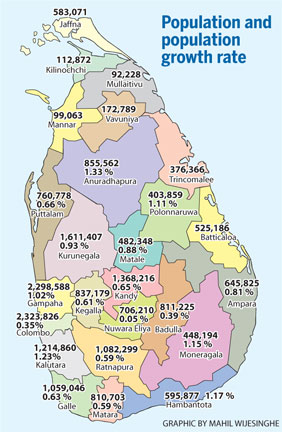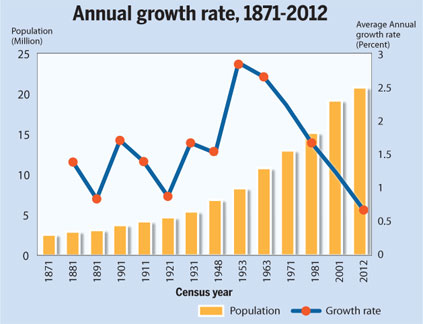Population growth declined to 0.7 percent
By Gamini WARUSHAMANA
  Sri Lanka's population as at March 21, 2012 was 20,277,597. This is
an increase of 1,480,340 persons or 7.9 percent compared with the 2001
Census which covered only 18 districts and an estimated population in
the other seven districts. Sri Lanka's population as at March 21, 2012 was 20,277,597. This is
an increase of 1,480,340 persons or 7.9 percent compared with the 2001
Census which covered only 18 districts and an estimated population in
the other seven districts.
The Department of Census and Statistics (DCS) last week released the
first report of the 14th population and housing Census. The report
reveals vital demographic data covering all provinces in the country
after a three-decade lapse and this is the first Census that covered the
North and East Provinces. After the 1981 Census.
The Census carried out in February and March 2012 is titled 'Census
of Population and Housing 2011'. The 2001 Census excluded the North and
East Provinces due to terrorism which prevailed. The latest Census
report gives socio-economic and demographic as well as politically
important information to decision makers.
The population in the Western Province is reported as 5,837,294 and
in the Northern Province it is 1,060,023. A population of over two
million is reported from Colombo (2,323,826) and Gampaha (2,298,588)
districts while Kurunegala (1,611,407), Kandy (1,368,216), Kalutara
(1,214,880), Ratnapura and Galle (1,059,046) districts reported
populations of more than one million.
The annual average population growth rate is 0.7 percent which is a
further decline compared to 1.0 percent in 2001.
The lowest population growth rate has been reported from the Nuwara
Eliya district with 0.05 percent and followed by Colombo with 0.35
percent. The 1.33 percent population growth rate in the Anuradhapura
district is the highest in the country.
Although the population is growing, there is a continuous declining
trend in the annual average population growth.
According to historical data, a baby boom was reported in the 1950s
and an annual average population growth rate reported at the Census held
on March 20, 1953 was 2.8 percent and was the highest since the first
Census held on March 27,1871. Thereafter,the population growth rate has
been continuously on the decline.
Higher population growth rates are reported from the Dry Zone
districts. Relatively high population growth rates in districts such as
Gampaha and Kalutara may be due to migration people seeking job
opportunities in Colombo.
The lowest growth rates were reported from the Nuwara Eliya and
Badulla districts which cover the estate sector.
 Lack of employment opportunities and the return to the North and the
East after the end of terrorism may be the reasons for the trend, the
report said. Lack of employment opportunities and the return to the North and the
East after the end of terrorism may be the reasons for the trend, the
report said.
The Western province is the most populous province in the country
where 28.8 percent of the country's population is living while the
Northern Province has been ranked as the least populated province with
only 5.2 percent.
The total population in the Western Province is 5,837,294 and it is
1,060,023 in the Northern Province. The population density of 3,438
(persons per square km) has been reported from the Colombo district and
the lowest from the Mullaitivu district.
This year the Census was conducted using the *de jure* method or by
enumerating persons at their place of usual residence. All other 13
Censuses were conducted using the *de facto * method which enumerate
persons at the place on the night of the Census. This change of the
Census method has created issues when comparing data. The report
clarifies this and says that difficulties faced by policy makers and
operational issues have compelled the Department to change the Census
method. If the *de facto* method was used, the demographic data
especially in the North and the East provinces would be changed because
security personnel would have to be counted at the location they were on
the night of the Census.
In the *de jure* method, the place of usual residence of a person for
Census purposes has been defined as " a place where a person has been
continuously living for more than six months or intends to stay for more
than six months continuously'".
The *de jure* method used this year gives more realistic data for
long-term planning, an official of the DCS told the Sunday Observer.
However, this report gives only preliminary information of the Census,
as proper data processing has not begun due to technical issues.
Officials said that scanning survey questionnaires have not yet
commenced and the Department was still looking for premises to begin
work.
The second report will also be on demographic information such as
age, sex, ethnic and religious distribution of the population will also
be released soon. However, it will take some time to release vital
economic and social information gathered in the Census unless data
processing is speeded-up.
|

